
The Prophalangopsis obscura (P. obscura) is one of only eight remaining descendants of an ancient katydid family of over 90-known species that lived during the Jurassic period (199.6 million to 145.5 million years ago). However, there is only one known specimen of the grasshopper-like insect. It was discovered in India in the mid-1800s and later donated to London's Natural History Museum. Scientists have now digitally recreated the P. obscura's long-lost call in the hopes of locating the insects in the wild.
"While we're only dealing with one specimen, it's one of just a handful of species which survives from a group of grasshopper and cricket relatives that likely dominated during the Jurassic," said study co-author Ed Baker, a bioacoustics researcher at the Natural History Museum in London.
Like their cricket relatives, katydids rub their wings or legs together to make sounds that attract mates. To emulate this, Baker and his team scanned the wings of specimen in the museum and created a 3D image of their surface structure. They then calculated the wings' resonant frequency — the natural frequency where a substance vibrates at the highest amplitude.
The resulting song is a low, 4.7-kilohertz pitch, which can be heard over long distances. While this is ideal for attracting mates, it also draws the attention of predators, specifically bats. The scientists, who published their findings in the journal PLOS ONE on August 10, 2022, believe the song provides valuable clues about where any remaining P. obscura specimens may be hiding.
"Comparing this species to modern relatives is interesting because it has large wings, which suggest it is capable of long flight, and sings a low-pitched song which travel over long distances," explained Barker. "Along with its habit of living out in the open, these features should make it an ideal target for bats as it is easier to detect. Its survival since the Jurassic suggests that it currently lives in an environment without bats that feed on free-flying insects."

The team theorizes that Jurassic-era insects are most likely living in regions of North India and Tibet, which are too cold for bats. They think the digitally-created song will help scientists easily identify the insects' calls and hopefully lead to the rediscovery of the elusive species.
Resources: NewAtlas.com, Phys.org, Natural History Museum
